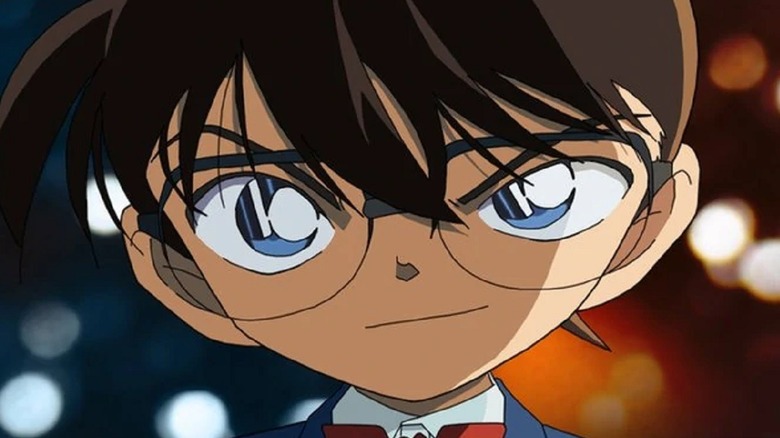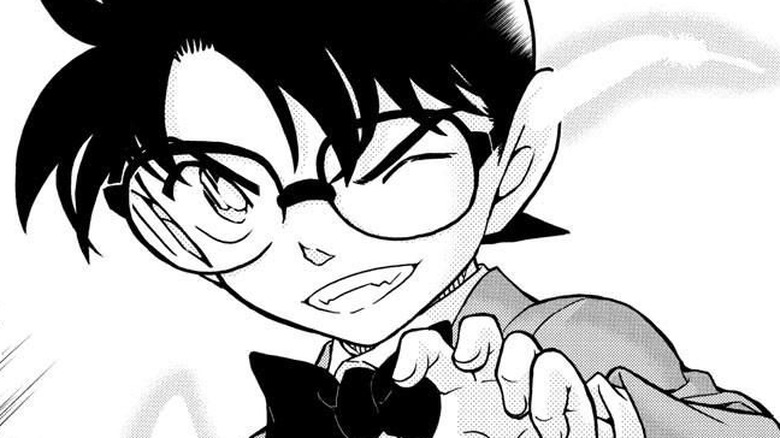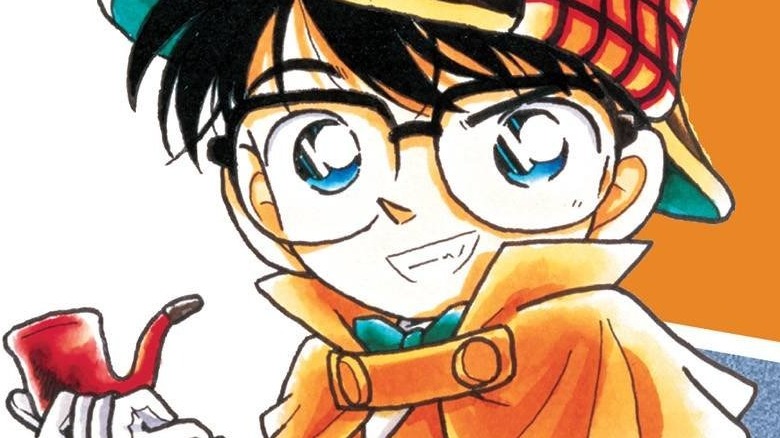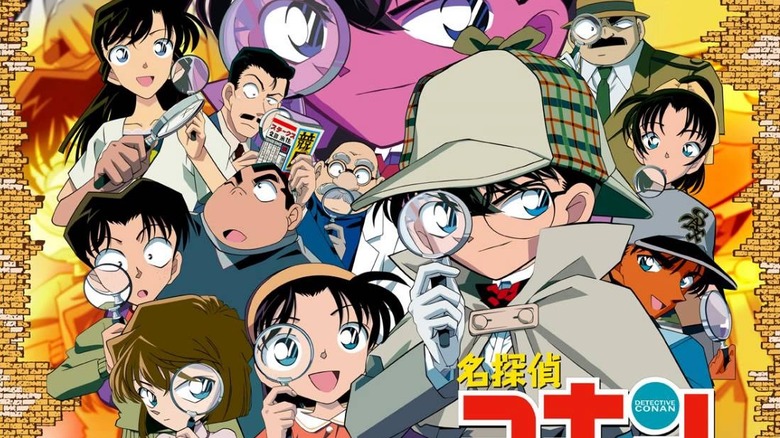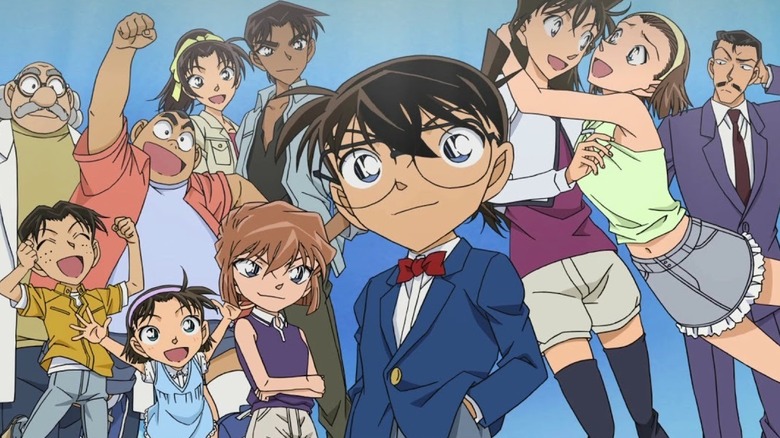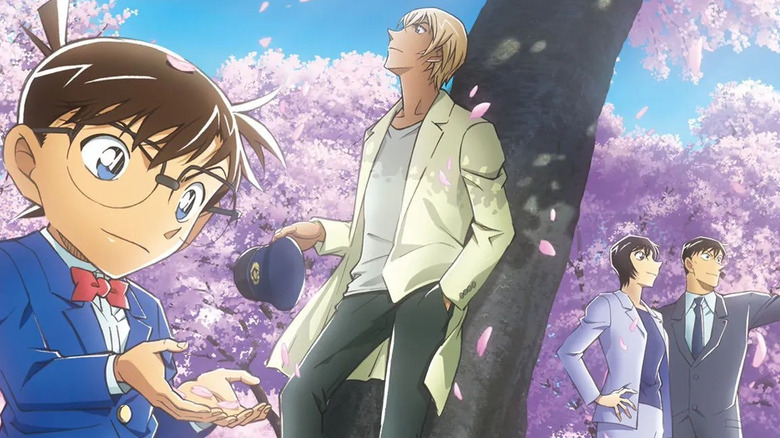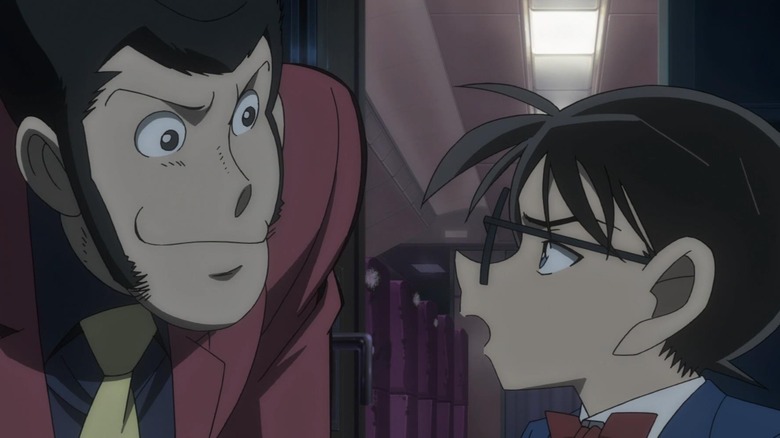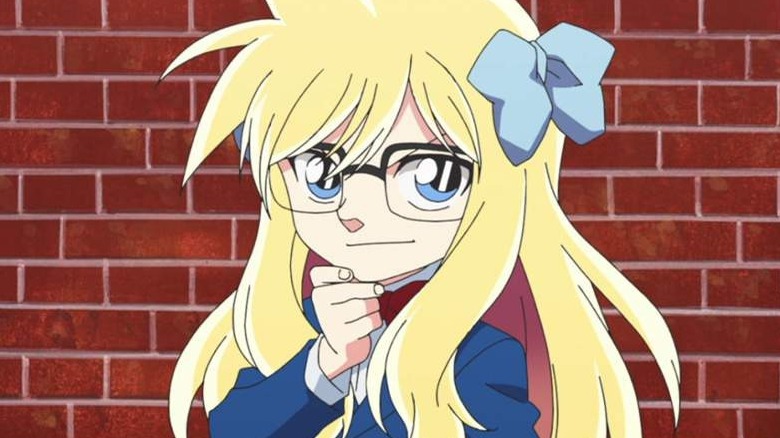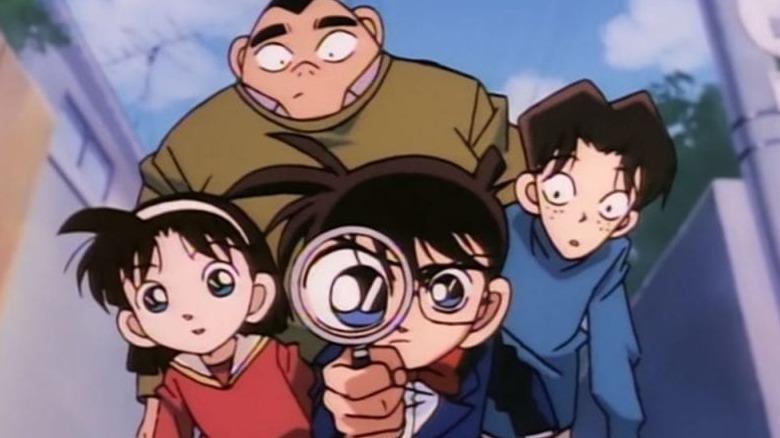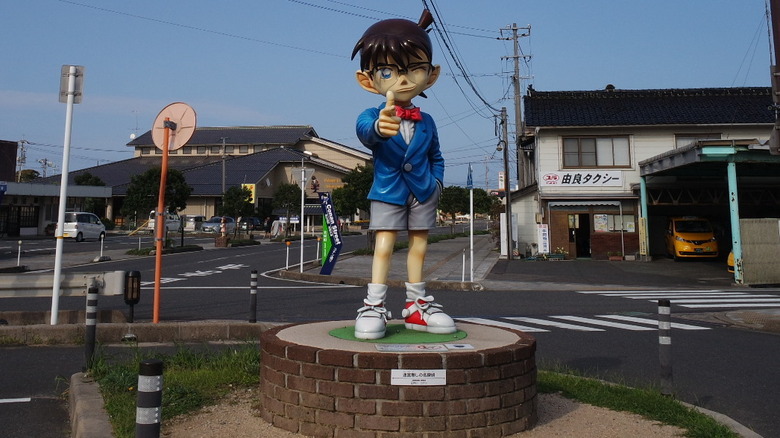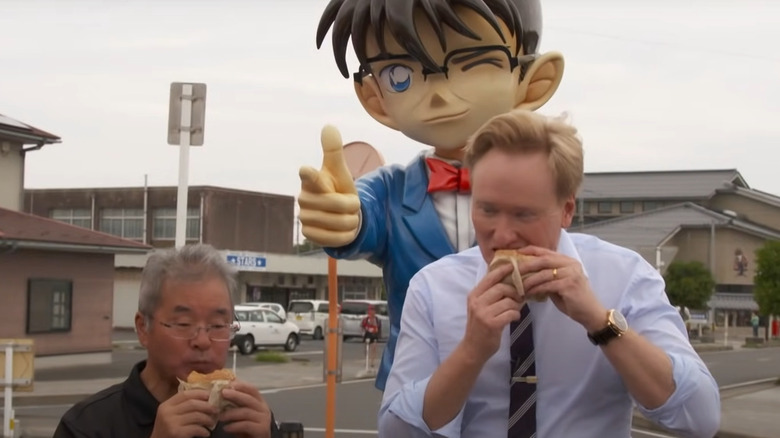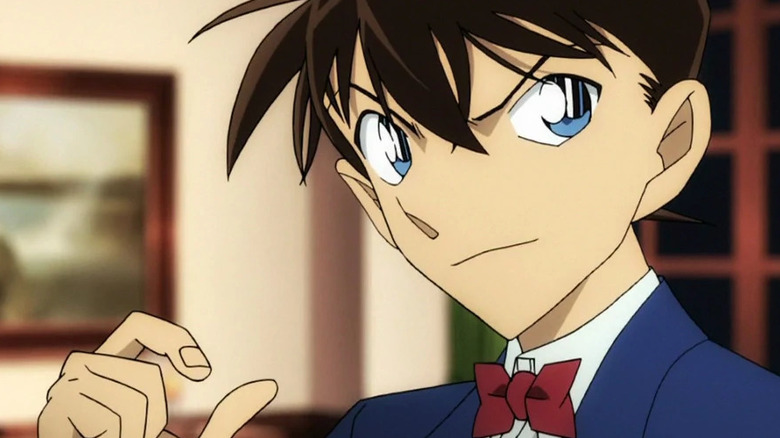The Untold Truth Of Detective Conan
Picture this: You're a high school student who has spent nearly his entire life obsessing over mystery fiction, developing incredible detective skills in the process. Your knack for cracking seemingly unsolvable cases has made you well-known throughout the country, to the point where the police force regularly asks for your help. One day, you witness a murder, but before you can escape and inform the authorities, the criminals catch you, feed you an experimental poison, and leave you for dead. Hours later, you miraculously wake up — but for some reason, you're stuck in the body of a 6-year-old. What do you do next?
If your answer is "assume a different name and begin living with your childhood sweetheart and her father at their detective agency so you can track down the criminals and return to your normal state," then congratulations: You're Shinichi Kudo, the star of the wildly popular manga-turned-anime "Detective Conan." Since its debut in January 1994, "Detective Conan" (known as "Case Closed" in the United States) has enjoyed international success. In 2021, the manga reached a circulation of 250 million copies across the world and the franchise's 24th anime movie was shown in 22 countries. What is it about this genius detective and his grade-school alter-ego that resonates so powerfully with fans worldwide?
From its roots to its future and everything in between, this is the untold truth of "Detective Conan."
Detective Conan is one of the most popular manga series ever
Created by Japanese manga artist Gosho Aoyama, "Detective Conan" revolves around Shinichi Kudo's quest to return to normal and bring the Black Organization — the group responsible for his transformation into an elementary school kid — to justice. To prevent his attackers from discovering that he survived and returning to finish him off, he comes up with an alternate identity and decides not to return to his house.
Shinichi's longtime friend Ran Mouri (who secretly harbors feelings for the teen detective) becomes Conan's guardian, taking him to her father's detective agency to live with them. Ran's dad Kogoro is a down-on-his-luck private investigator who is hilariously terrible at solving cases, so Conan's arrival proves to be fortuitous for his career. Unbeknown to Kogoro — and virtually everyone else around them — Conan uses his superior detective skills to solve crimes and then gives Kogoro all the credit. He puts the detective to sleep with tranquilizer needles and mimics him with a voice-changing bowtie when explaining his deductions.
Readers first met the pint-sized problem-solver in the pages of "Weekly Shonen Sunday" back in 1994. The series became a massive hit: With over 250 million copies in circulation worldwide as of 2021, it is one of the best-selling manga on the planet, per Anime News Network. "Detective Conan" also has the distinction of being the first series in the magazine's history to reach 1,000 chapters, a feat it accomplished in 2017.
Conan's name is inspired by two famous fiction writers
If it seems a bit strange to you that a Japanese boy would have a traditionally Western name like Conan, there's a perfectly reasonable explanation for it. Right after Shinichi wakes up and realizes that he's stuck in a child's body, he heads to his house (where he lives alone) and runs into his next-door neighbor, the eccentric inventor Professor Hiroshi Agasa. After he tells the old man about what happened, they go inside to discuss their next steps.
When Ran arrives to look for Shinichi, the little boy immediately catches her attention. Scrambling to come up with an answer when Ran asks what his name is, he leans back against a bookshelf and takes inspiration from two authors: Sir Arthur Conan Doyle, the creator of Sherlock Holmes (Shinichi's favorite character), and Edogawa Ranpo, a pioneer in Japanese mystery fiction. That's how Conan Edogawa was born.
"Detective Conan" creator Gosho Aoyama paid homage to these two famous novelists when crafting his manga's protagonist, but they weren't the only ones who sparked his imagination. An exhibit at the Aoyama Manga Factory in Hokuei (the mangaka's hometown) reveals the names of the other famous literary detectives that inspired him. Along with Sherlock Holmes and Edogawa's Kogoro Akechi, Aoyama liked Raymond Chandler's Philip Marlowe and Agatha Christie's brilliant Belgian sleuth Hercule Poirot.
The series is about more than just the titular detective
While it's primarily about Shinichi's quest to revert to his adult state, "Detective Conan" also features an ever-growing supporting cast, each fleshed out and given their own back stories, unique characteristics, and goals. Ran, for instance, is more than just the obligatory love interest: She's a powerful karate champion who comes close to figuring out Conan's secret multiple times in the series. Conan's friends at elementary school — Mitsuhiko, Ayumi, and Genta — are kindred spirits who call themselves the Detective Boys, showing an aptitude for mystery-solving that has proven valuable to the police on certain occasions.
There's also Hattori Heiji, who starts out as Shinichi's rival but eventually becomes one of his most trusted allies; Ai Haibara, the scientist who created APTX 4869 (the experimental poison that shrank Shinichi) and used it on herself to escape the Black Organization, causing her to also turn into a child; Shuichi Akai, a mysterious FBI operative with unparalleled sharpshooting abilities; and Masumi Sera, a high school detective who may have figured out Conan's true identity.
Even the villains in this series are compelling. The Black Organization is a group that operates from the shadows, and each of its members has a codename based on an alcoholic beverage. Gin is one of its deadliest operatives, often accompanied by his partner Vodka. Vermouth is a master of disguise who is aware of Shinichi's existence as Conan, while Bourbon is an incredibly skilled intelligence-gatherer who is actually an undercover cop.
Conan is voiced by the creator's ex-wife
Two years after its manga debut, "Detective Conan" successfully made the leap from the page to the screen. After premiering in Japan on January 8, 1996, the "Detective Conan" anime went on to be broadcast in at least 40 different countries and has released over a thousand episodes to date. That number doesn't even include the various TV specials, OVAs, and feature films that have come out over the decades. While there are some minor differences between the manga and the anime, the adaptation closely adheres to the source material for the most part, which helped it become a success. However, perhaps the main reason "Detective Conan" works so well is Minami Takayama, who has been bringing Conan to life since the beginning.
A voice actor and pop star, Takayama married "Detective Conan" creator Gosho Aoyama in 2005. According to Anime News Network, the Japanese press dubbed it the "wedding of the Conans." The media revealed that they had split in 2007, though Takayama's agency refused to comment, citing "the private nature" of the topic. While the reason behind their divorce was never disclosed to the public, the two have seemingly maintained an amicable relationship, as Takayama still serves as Conan's voice actor in the TV series and movies. She has even briefly voiced Conan in a live-action film — there have been four "Detective Conan" TV specials, as well as a 13-episode live-action TV series. The live-action adaptations tend to focus more on Shinichi before his transformation, acting more like prequels.
Conan is more popular than Marvel in Japan
Given the level of popularity that "Detective Conan" enjoys in Japan, it's not surprising that the franchise has spawned an ongoing film series. In fact, apart from 2020 (because of the COVID-19 pandemic), there has been a new animated "Detective Conan" movie every single year since 1997. The films are not really considered part of the canon, but Gosho Aoyama still likes to put his two cents in, suggesting settings and even writing key scenes. The first "Detective Conan" movie, entitled "The Time Bombed Skyscraper," debuted in Japanese theaters in April 1997 and features Conan dealing with a crazed terrorist. Nine years later, Funimation released it on DVD in North America, marketing it as "Case Closed: The Movie."
The 25th film in the franchise, "The Bride of Halloween," premiered in Japan on April 15, 2022. It opened strongly and has raked in more than $65 million at the box office. Proof of Japan's intense love for the "Detective Conan" movies lies in the fact that, in the country, the child detective's feature films are more popular than the Marvel Cinematic Universe. "Avengers: Infinity War" was dominating everywhere but Japan in April 2018, when "Detective Conan: Zero the Enforcer" was the king of the box office. The following year, "Detective Conan: The Fist of Blue Sapphire" made 9.19 billion yen ($85.19 million) in Japan, compared to the $55 million "Avengers: Endgame" took. The much-hyped team-up movie ended Conan's three-week stint at the top of the ratings when it dropped, but "The Fist of Blue Sapphire" reclaimed the top spot the following week.
The Conan crossovers you might not know about
Testing the skills of a gifted detective requires an equally brilliant criminal worthy of their attention — and in the world of Conan Edogawa, the immaculately dressed magician Kaitou Kid fills that role. This so-called "phantom thief kid" is actually an earlier creation of Gosho Aoyama. He starred in his own manga series called "Magic Kaito," which debuted in a 1987 issue of "Weekly Shonen Sunday." He has since been seamlessly integrated into the continuity of "Detective Conan," with his sporadic appearances proving to be enough to make him one of the franchise's most popular characters. However, he's not the only gentleman thief the great little gumshoe has locked horns with. Detective Conan has also gone head to head with none other than Lupin III, the grandson of the legendary thief Arsène Lupin and a massively popular manga character himself.
These two titans of Japanese pop culture have clashed twice: First in a 2009 TV special titled "Lupin III vs. Detective Conan," which was followed in 2013 by a feature film bearing the same title, but with an updated story. In the TV special, the small sleuth and the slender swindler are forced to work together to save the new queen of the fictional kingdom Vespania from an assassination attempt. The film, on the other hand, starts with Lupin being coerced into pulling off a theft dressed as the Kaitou Kid, and ends with him and Conan joining forces to thwart the true villain. You don't have to see the TV special first, though — as Kotaku pointed out in its review of the movie — it certainly helps.
Detective Conan is often referenced in other anime
Because of the enduring success and influence of "Detective Conan," the common tropes in the series — as well as Conan Edogawa's iconic character design — have become an indelible part of Japanese pop culture. Unsurprisingly, this has resulted in "Detective Conan" being referenced in various anime over the years. In the first season of "Gintama," for instance, there's a scene where characters discuss the possibility that a suspect they're looking for is the "mystery shadow," the black, humanoid form with a devilish smile that "Detective Conan" uses when showing how a crime was committed without revealing the criminal's identity.
In "Inuyasha," a character dresses up as Conan (complete with the red bowtie) for a date, and in another sequence, Ran and Shinichi can be seen walking in the background. Meanwhile, "Yakitate!! Japan" features a clown successfully disguising himself as Conan Edogawa, albeit with evil-looking eyes. "Jashin-chan Dropkick" also contains a nod to "Detective Conan," as do "Bakemonogatari," "Hayate the Combat Butler," and "No Game No Life." That's just a fraction of the Conan references that have popped up over the years.
The real reason Detective Conan never took off in the States
Despite being a huge hit in Japan, "Detective Conan" has never been massive with U.S. audiences. Why hasn't it taken off? It could be due to the considerable confusion resulting from Funimation's initial attempts to bring "Detective Conan" to American shores.
Eight years after the debut of the "Detective Conan" anime, Funimation started showing an English dub of the show to U.S. viewers. The characters were given new Western names — Shinichi Kudo became Jimmy Kudo, while Ran Mouri became Rachel Moore. Even the title was changed from "Detective Conan" to "Case Closed" (due to "unspecified legal reasons," per CBR).
A few months later, Viz Media started distributing English translations of the manga, with characters' names changed to match Funimation's dub. However, when Funimation's English-dubbed run ended in 2009, Viz Media's manga releases soon reached the point beyond where the anime stopped. This meant that they had to come up with an alternative name for Ai Haibara, a significant character in the story. Viz Media called her Anita Hailey, which became a problem when Funimation later brought two "Detective Conan" movies to U.S. shores and ended up giving Haibara another English name (Vi Graythorn).
At some point, Crunchyroll made some of the episodes available on its platform. Even Netflix got in on the action for a spell. Still, "Case Closed" hasn't quite achieved the status that "Detective Conan" enjoys in its homeland, and we believe all the confusing name changes are partially to blame.
Detective Conan Cafes are now popping up overseas
Have you ever wondered how the sandwiches from Cafe Poirot — the eatery located right under the Mouri Detective Agency — actually taste? Have you ever wanted to eat French toast served inside a giant replica of a poison capsule? Do you want to take photos of yourself sipping cream soda from a glass with a bowtie? If so, then the Detective Conan Cafe is for you.
As Japan Wireless reports, these pop-up sites open for a limited time, sometimes coinciding with the release of a new film. In 2022, as part of the promotional campaign for the 25th "Detective Conan" movie "The Bride of Halloween," Detective Conan Cafes opened at seven sites across Japan: Sapporo, Abeno, Nagoya, Shinjuku, Umeda, Solamachi, and Shibuya. The menu (good for dine-in or takeaway) is full of themed items that fans are sure to love, offering the likes of the Cafe Poirot Sandwich, the Criminal's Meatball Ratatouille, Ran's Lemon Pie, and Toru Amuro's Cream Lemon Soda.
In addition to food, fans can purchase exclusive merchandise and take photos of themselves with character standees. And it's not just limited to fans in Japan — there have been Detective Conan Cafes outside of the country. Per The Nation Thailand, the themed eatery opened a branch in Bangkok, Thailand in 2018. This marked the first time a Detective Conan Cafe had popped up overseas.
There's a town (and even an airport) dedicated to Detective Conan
"Detective Conan" creator Gosho Aoyama was born in Daiei, a town in Tottori Prefecture. Daiei was part of a merger in 2005, resulting in the creation of a brand-new town called Hokuei. Due to the tremendous impact that Aoyama's character has had on Japanese pop culture — and likely as a way to boost tourism in the area — several "Detective Conan" attractions exist in Hokuei, which is now popularly known as Conan Town.
There are statues of the main characters all over Conan Town. A monument of Conan Edogawa striking his signature pose greets you at the town's entrance, a train station that has been renamed Conan Station. Even the taxis and manhole covers in this town bear Conan's image! Attractions include the Hokuei Town Library, Conan Bridge (decorated with bronze statues of the boy detective and set against an Instagram-worthy view), Conan's House, and Beika Shopping Street, which is full of "Detective Conan" merchandise. And of course, there's the Gosho Aoyama Manga Factory, a museum/cafeteria/gift shop dedicated to the creator and his works and likely the town's biggest draw (pun intended).
The "Detective Conan" mania doesn't stop at Conan Town. If you swing by the Tottori Sand Dunes — which is about two hours away by train — you'll see the Detective Conan Airport. And yes, it's an actual, operational airport.
Detective Conan meets Conan O'Brien
In 2018, the world got a crossover that it didn't know it needed until it happened. In a segment on his show, American late night host Conan O'Brien jokingly called out "Detective Conan" for allegedly making money off his image, which he suggested was the inspiration for the best-selling manga. He begins his hilarious tirade by bemoaning how in Japan, the first thing that pops up on an internet search for "Conan" is not his face, but Conan Edogawa's. He also pointed out some undeniable similarities between him and the small sleuth. "He has distinctive hair, he always wears a suit, spends all day asking people questions, and is extremely cartoonish," O'Brien said, adding that he is also "a man trapped in a child's body." He also mentions Conan Town before ending his scripted rant by demanding 3 trillion yen (over $22 billion) as compensation.
This comedic feud between Conan the host and Conan the detective would come to an entertaining conclusion in an edition of "Conan Without Borders." O'Brien and his team visited Conan Town following Hokuei mayor Akio Matsumoto's equally frivolous counter-demand for the host to send "15,000 American hamburgers" to the town. After accidentally flying to the wrong airport and having to jump in a cab so as not to disappoint the waiting fans, O'Brien was appointed mayor for the day. He spent his time as Hokuei mayor enjoying the many "Detective Conan" attractions around town and bumbling through awkward situations in his signature fish-out-of-water style.
When will Detective Conan end?
While "Detective Conan" fans will tell you that watching Conan Edogawa crack unsolvable cases never gets old, one has to wonder if the pint-sized protagonist will ever age. When will he finally bring those responsible for his curious predicament to justice and return to his true form? As it turns out, Gosho Aoyama has long had the ending of "Detective Conan" planned out. In a 2007 interview with the Japanese daily newspaper Sankei Shimbun (via Anime News Network), Aoyama stated that the ending he had in mind "will not betray the hopes of fans."
Considering how it has been more than a decade since that interview, it's safe to assume that Shinichi's quest to obtain a permanent antidote for APTX 4869 will go on for a bit longer. There's no evidence of fan fatigue yet, with the newer films in the "Detective Conan" series continuing to set and break box office records. As Aoyama said in his Sankei Shimbun interview, he "doesn't feel much pressure" when it comes to Conan. "I write what feels right to me," he added. "I feel lucky that I'm able to do that."
